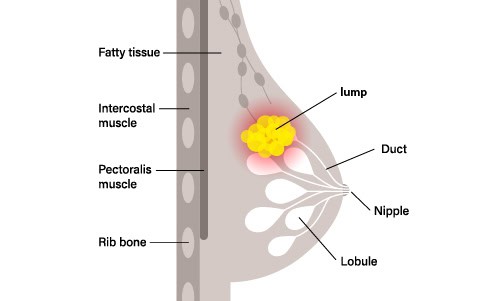A breast lump, a concerning discovery for many, demands prompt attention. Its evaluation involves diagnostic imaging, biopsy, and histological examination. Treatment addresses complications like cysts, fibroadenomas, and malignancies, ensuring comprehensive care.
If you're considering treatment for a breast lump, reach out to us or book a direct appointment with our breast surgeon. At the CK Birla Hospital, we are dedicated to ensuring that your breast lump treatment is as safe, comfortable, and effective as possible. We're here to guide you every step of the way toward a successful recovery.

Possible causes or reasons of breast lumps encompass:
Not treating a breast lump promptly poses various risks, such as:
Timely evaluation and treatment are crucial to minimise these risks and ensure the best outcomes.
Breast lumps vary in type, with many being benign and others malignant. Common types include:
Treatment for breast lumps varies based on factors like lump type and size. The different types of treatment include:
The cost of a breast lump treatment varies as per the specific type of treatment advised by a healthcare provider, such as:
The cost can also vary widely depending on several factors, including the location, the extent of the treatment, the doctor’s experience, and the hospital’s pricing structure.
To get an explicit estimate for the cost of a breast lump treatment at the CK Birla Hospital, contact the hospital directly. Additionally, you can consult with our board-certified breast surgeon to discuss your specific needs and receive a personalised quote for the treatment.
Biopsy
It involves a sample examined under a microscope to determine benign or malignant nature. The types of biopsy are:
Once diagnosed, treatment options are considered based on type and stage, including surgery, radiation, chemotherapy, hormone therapy, or targeted therapy.
Consultation and Examination
Pre-surgery Preparation
Fasting before Surgery
Personal Care
Clothing
Arrange Support
Post-surgery Care
Medical history and Information
Ask Questions
A breast lump is a localised swelling or growth within the breast tissue. It can vary in size and texture and may feel like a hard knot or a soft mass.
No, the majority of breast lumps are benign (non-cancerous). However, any new lump in the breast should be evaluated by a healthcare provider to determine its cause and rule out cancer.
Symptoms that warrant medical attention include a new lump that feels hard or irregular, changes in the size or shape of the breast, skin changes (such as redness, puckering, or dimpling) and nipple changes (such as inversion, discharge, or pain).
It’s important to see a doctor promptly if you notice any new breast lump or changes in your breast tissue. This is especially crucial if you have other symptoms such as pain, skin changes, or nipple discharge.